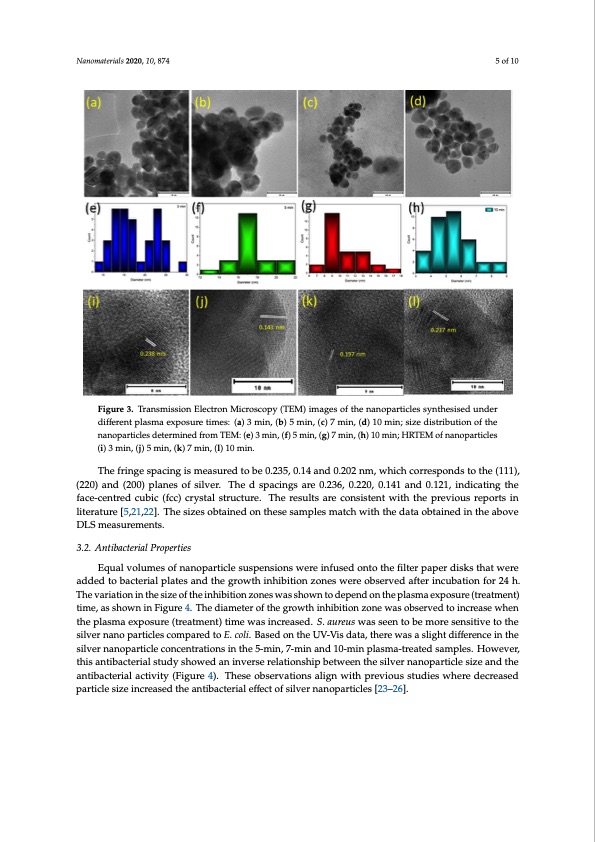
PDF Publication Title:
Text from PDF Page: 005
The morphology of the silver nanoparticles has been analysed using TEM. Figure 3 (a–d) show the images of the particles synthesised under 3, 5, 7 and 10 min of cold plasma exposure. The shape is near spherical and the average diameters of the nanoparticles were 17.9 ± 8.9, 14.3 ± 1.6, 10.6 ± 2.3, and 5.4 ± 1.4 nm, respectively. The High‐resolution transmission electron microscopy (HRTEM) Naimnomagatesriaolsf 2t0h2e0,s1i0lv, 8e7r4nanoparticles synthesised under different plasma exposure times are shown i5nof 10 the Figure 3 (e–g). FiFgiugurere3.3.TTrarannssmiissiionElectronMiicrrossccooppyy(T(TEEMM))imimagaegsesofotfhtehenanaonpoaprtaicrlteicslessynstyhnetshiseesdisuednduenrder didffifefreernenttpplalassmaaeexposuretimes::((aa))33minin,,(b(b))55mmini,n(,c)(c7)m7imn,in(d,)(d1)01m0inm;insi;zseizdeisdtriisbturitbiountiofntohefthe nanoparticles determined from TEM : (e) 3 min, (f) 5 min, (g) 7 min, (h) 10 min; HRTEM of nanoparticles determined from TEM: (e) 3 min, (f) 5 min, (g) 7 min, (h) 10 min; HRTEM of nanoparticles nanoparticles (i) 3 min, (j) 5 min, (k) 7 min, (l) 10 min. (i) 3 min, (j) 5 min, (k) 7 min, (l) 10 min. The fringe spacing is measured to be 0.235, 0.14 and 0.202 nm, which corresponds to the (111), The fringe spacing is measured to be 0.235, 0.14 and 0.202 nm, which corresponds to the (111), (220) and (200) planes of silver. The d spacings are 0.236, 0.220, 0.141 and 0.121, indicating the face‐ (220) and (200) planes of silver. The d spacings are 0.236, 0.220, 0.141 and 0.121, indicating the centred cubic (fcc) crystal structure. The results are consistent with the previous reports in literature face-centred cubic (fcc) crystal structure. The results are consistent with the previous reports in [5,21,22]. The sizes obtained on these samples match with the data obtained in the above DLS literature [5,21,22]. The sizes obtained on these samples match with the data obtained in the above measurements. DLS measurements. 3.2. Antibacterial Properties 3.2. Antibacterial Properties Equal volumes of nanoparticle suspensions were infused onto the filter paper disks that were Equal volumes of nanoparticle suspensions were infused onto the filter paper disks that were added to bacterial plates and the growth inhibition zones were observed after incubation for 24 h. added to bacterial plates and the growth inhibition zones were observed after incubation for 24 h. The variation in the size of the inhibition zones was shown to depend on the plasma exposure The variation in the size of the inhibition zones was shown to depend on the plasma exposure (treatment) (treatment) time, as shown in Figure 4. The diameter of the growth inhibition zone was observed to time, as shown in Figure 4. The diameter of the growth inhibition zone was observed to increase when increase when the plasma exposure (treatment) time was increased. S. aureus was seen to be more the plasma exposure (treatment) time was increased. S. aureus was seen to be more sensitive to the sensitive to the silver nano particles compared to E. coli. Based on the UV‐Vis data, there was a slight silver nano particles compared to E. coli. Based on the UV-Vis data, there was a slight difference in the difference in the silver nanoparticle concentrations in the 5‐min, 7‐min and 10‐min plasma‐treated silver nanoparticle concentrations in the 5-min, 7-min and 10-min plasma-treated samples. However, this antibacterial study showed an inverse relationship between the silver nanoparticle size and the antibacterial activity (Figure 4). These observations align with previous studies where decreased particle size increased the antibacterial effect of silver nanoparticles [23–26].PDF Image | Bactericidal Silver Nanoparticles by Plasma Processing

PDF Search Title:
Bactericidal Silver Nanoparticles by Plasma ProcessingOriginal File Name Searched:
nanomaterials-10-00874.pdfDIY PDF Search: Google It | Yahoo | Bing
Turbine and System Plans CAD CAM: Special for this month, any plans are $10,000 for complete Cad/Cam blueprints. License is for one build. Try before you buy a production license. More Info
Waste Heat Power Technology: Organic Rankine Cycle uses waste heat to make electricity, shaft horsepower and cooling. More Info
All Turbine and System Products: Infinity Turbine ORD systems, turbine generator sets, build plans and more to use your waste heat from 30C to 100C. More Info
CO2 Phase Change Demonstrator: CO2 goes supercritical at 30 C. This is a experimental platform which you can use to demonstrate phase change with low heat. Includes integration area for small CO2 turbine, static generator, and more. This can also be used for a GTL Gas to Liquids experimental platform. More Info
Introducing the Infinity Turbine Products Infinity Turbine develops and builds systems for making power from waste heat. It also is working on innovative strategies for storing, making, and deploying energy. More Info
Need Strategy? Use our Consulting and analyst services Infinity Turbine LLC is pleased to announce its consulting and analyst services. We have worked in the renewable energy industry as a researcher, developing sales and markets, along with may inventions and innovations. More Info
Made in USA with Global Energy Millennial Web Engine These pages were made with the Global Energy Web PDF Engine using Filemaker (Claris) software.
Infinity Turbine Developing Spinning Disc Reactor SDR or Spinning Disc Reactors reduce processing time for liquid production of Silver Nanoparticles.
| CONTACT TEL: 608-238-6001 Email: greg@infinityturbine.com | RSS | AMP |